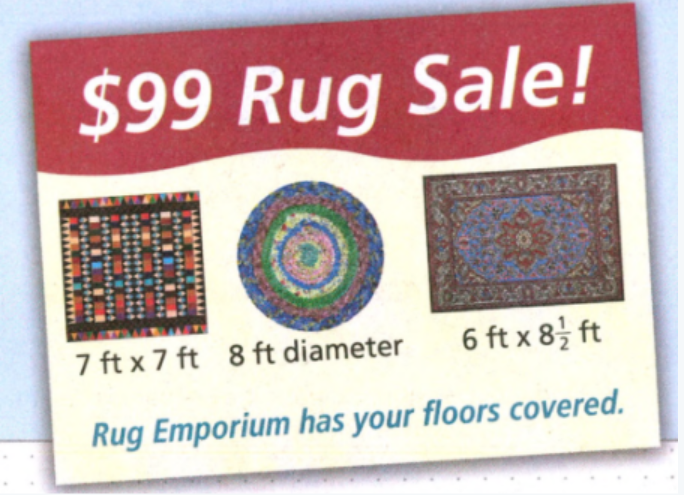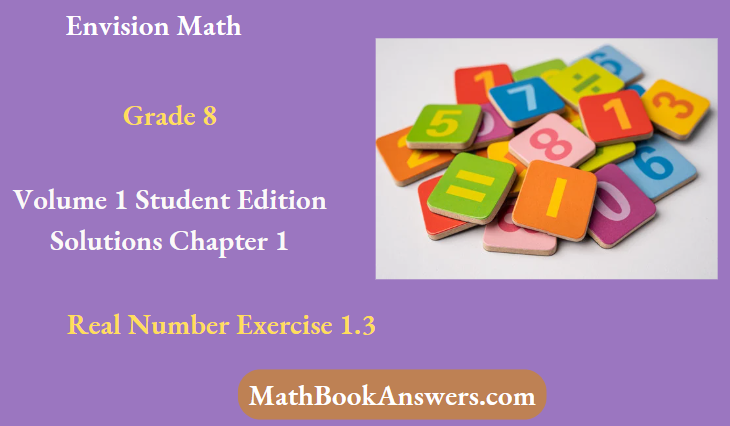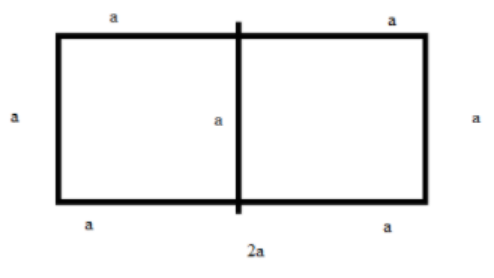Envision Math Grade 8 Volume 1 Chapter 1 Exercise 1.3 Real Number Solutions
Page 19 Exercise 1 Answer
Given that, Courtney and Malik are buying a rug to fit in a 50-square-foot space. We need to determine which rug should they purchase.

We need to buy a rug to fit in a 50-square-foot space. Therefore, we need to buy a rug which is smaller than this.
The first rug will be,
7ft × 7ft = 49ft2
The second rug is of circle-shaped, thus, its area will be,
A = πr2
A = \(\frac{22}{7} \times 4^2\)
A = 50.2857
The third rug area will be,
⇒ \(6 \mathrm{ft} \times 8 \frac{1}{2} \mathrm{ft}=6 \mathrm{ft} \times \frac{17}{2} \mathrm{ft}\)
=3 × 17ft2
= 51ft2
Only the first rug is smaller than the 50 square foot space. Therefore, it is
Courtney and Malik should purchase the first rug whose dimensions are 7ft x 7ft

Envision Math Grade 8 Volume 1 Chapter 1 Exercise 1.3 Real Number Solutions
Envision Math Grade 8 Volume 1 Chapter 1 Exercise 1.3 Real Number Solutions Page 19 Exercise 1 Answer
We need to explain how we have decided which rug Courtney and Malik should purchase.
As we need to find a rug which has to be fit in the space of 50 square foot.
We need to buy a rug which is smaller than the space.
Thus, we need to find the areas of all three rugs and then decide which one’s area is less than 50 square foot.
The area of the first rug is, A=49ft2
The area of the second rug is, A=50.2857ft2
The area of the third rug is, A = 51ft2
We have decided which rug to buy by finding the areas of all three rugs and determining which one’s area is smaller than 50 square foot.
Page 20 Question 1 Answer
We need to explain how we can compare and order rational and irrational numbers.
We can compare and order rational and irrational numbers by the following ways:
Irrational numbers cannot be represented as a fraction.
Irrational numbers are non-terminating and non-repeating in nature.
Only terminating and repeating decimals can be represented as a fraction.
Rational numbers are terminating and repeating in nature.
Only rational numbers can be represented as a fraction while irrational numbers cannot.
Rational numbers are terminating and repeating while irrational numbers are non-terminating and non-repeating in nature.
Envision Math Grade 8 Exercise 1.3 Real Numbers Answers
Envision Math Grade 8 Volume 1 Chapter 1 Exercise 1.3 Real Number Solutions Page 20 Exercise 1 Answer
We need to determine which decimals we can use to find a better approximation.
Find the two closest consecutive perfect squares of the given number √74
The perfect squares which is closest to them is √64 and √81
Thus, the given number √74 is between the numbers 8 and 9
As we can see that the number √74 is closest to 9 more than the number 8.
Thus, 8 < √74 < 9
8.5 < √74
Thus, squaring the decimals above 8.5 and below 9 we get,
8.6 × 8.6 = 73.96
8.7 × 8.7 = 75.69
8.8 × 8.8 = 77.44
8.9 × 8.9 = 79.21
Therefore, the number √74 is about 8.6ft
For finding the better approximation, square decimals between 8.5 and 8.9 since √74 > 8.5
Page 20 Exercise 1 Answer
We need to find between which two whole numbers is √12
The two closest perfect square roots of the given number √12 is,√9 and √16
Thus,
√9 < √12 < √16
3 < √12 < 4
Thus, the given number is between 3 and 4
The number √12 lies between the whole numbers 3 and 4
Envision Math Grade 8 Volume 1 Chapter 1 Exercise 1.3 Real Number Solutions Page 21 Exercise 2 Answer
We need to compare and order the following numbers:
√11, \(2 \frac{1}{4}\), −2.5, 3.6, −3.97621…
Finding where the given square roots numbers lie in the number line, thus,
√9 < √11 < √16
3 < √11 < 4
3 < √11 < 3.5
Since it is closer to the number 9 than 16.
\(2 \frac{1}{4}\) = 2.250
Thus, ordering the given numbers, we get,
\(-3.97621 \ldots<-2.5<2 \frac{1}{4}<\sqrt{11}<3 . \overline{6}\)Comparing and ordering the given numbers, we get,
\(-3.97621 \ldots<-2.5<2 \frac{1}{4}<\sqrt{11}<3 . \overline{6}\)
Page 22 Exercise 1 Answer
We need to explain how we can compare and order rational and irrational numbers.
Irrational numbers cannot be represented as a fraction.
Irrational numbers are non-terminating and non-repeating in nature.
Only terminating and repeating decimals can be represented as a fraction.
Rational numbers are terminating and repeating in nature.
Only rational numbers can be represented as a fraction while irrational numbers cannot.
Find some rational number closer to the irrational number. Then compare the other one with the obtained estimate for the irrational number to order them.
Find some rational number closer to the irrational number. Then compare the other one with the obtained estimate for the irrational number to order them.
Envision Math Grade 8 Volume 1 Chapter 1 Exercise 1.3 Real Number Solutions Page 22 Exercise 3 Answer
We need to find which one is a better approximation of √20. The given approximated values are 4.5 or 4.47
Finding where the given square root number lie in the number line, thus,
√16 < √20 < √25
4 < √20 < 5
The number 20 is closer to 4 than 5.
Thus, 4 < √20 < 4.5
Thus, squaring the decimal values to find a better estimate, we get,
4.47 × 4.47 = 19.9809
4.5 × 4.5 = 20.25
Thus, 4.47 is a better estimate.
4.47 is a better estimate of √20
Real Number Solutions Grade 8 Exercise 1.3 Envision Math
Envision Math Grade 8 Volume 1 Chapter 1 Exercise 1.3 Real Number Solutions Page 22 Exercise 5 Answer
We need to approximate √18 to the nearest tenth and plot the number on a number line.
Finding where the given square root number lie in the number line, thus,
√16 < √18 < √25
4 < √18 < 5
4 < √18 < 4.5
since √18 is closer to 4 than 5.
Thus, squaring the decimal values to find a better estimate, we get,
4.1 × 4.1 = 16.81
4.2 × 4.2 = 17.64
4.3 × 4.3 = 18.49
4.4 × 4.4 = 19.36
Thus, the number 4.2 is the better estimate.

The number 4.2 is the better estimate.

Envision Math Grade 8 Volume 1 Chapter 1 Exercise 1.3 Real Number Solutions Page 22 Exercise 6 Answer
We need to compare 5.7145… and √29 and find which one is greater than the other.
Finding where the given square root number lie in the number line, thus,
√25 < √29 < √36
5 < √29 < 6
5 < √29 < 5.5
The number √29 is closer to 5 than 6
Thus, squaring the decimal values to find a better estimate, we get,
5.2 × 5.2 = 27.04
5.3 × 5.3 = 28.09
5.4 × 5.4 = 29.16
Thus, 5.3 is a better estimate of √29
Therefore, √29 < 5.7145…
Comparing the numbers, we get, √29 < 5.7145…
Page 23 Exercise 9 Answer
We need to compare -1.9612… and -√5 and find which one is greater than the other.
Finding where the given square root number lie in the number line, thus,
−√4 < −√5 < −√9#
−2 < −√5 < −3
Therefore, ordering the given numbers we get,
−√5 < -1.96312…
Ordering the numbers, we get,
−√5 < -1.96312…
Envision Math Grade 8 Chapter 1 Exercise 1.3 Solutions
Envision Math Grade 8 Volume 1 Chapter 1 Exercise 1.3 Real Number Solutions Page 24 Exercise 13 Answer
Given that, Rosie is comparing √7 and 3.4444….. She says that
√7 > 3.4444… because √7 = 3.5.
We need to check whether the comparison is correct or not.
Finding where the given square root number lie in the number line, thus,
√4 < √7 < √9
2 < √7 < 3
2.5 < √7 < 3
Thus, √7 < 3.4444…
The comparison made by Rosie is incorrect.
Given that, Rosie is comparing √7 and 3.4444….. She says that
√7 > 3.4444… because √7 = 3.5.
We need to find the mistake Rosie likely made.
Finding where the given square root number lie in the number line, thus,
√4 < √7 < √9
2 < √7 < 3
2.5 < √7 < 3
Thus,
√7 < 3.444…
√7 = 2.646
The comparison made by Rosie is incorrect since the value of √7 = 2.646
Envision Math Grade 8 Volume 1 Chapter 1 Exercise 1.3 Real Number Solutions Page 24 Exercise 14 Answer
We need to approximate −√23 to the nearest tenth. Also, draw the point on the number line.
Finding where the given square root number lie in the number line, thus,
−√16 > −√23 > −√25
−4 > −√23 > −5
−4.5 > −√23 > −5
Thus, squaring the decimal values to find a better estimate, we get,
4.6 × 4.6 = 21.16
4.7 × 4.7 = 22.09
4.8 × 4.8 = 23.04
4.9 × 4.9 = 24.01
So, a better approximate is -4.7
The better approximate is -4.7

Envision Math 8th Grade Exercise 1.3 Step-By-Step Real Number Solutions
Envision Math Grade 8 Volume 1 Chapter 1 Exercise 1.3 Real Number Solutions Page 24 Exercise 15 Answer
Given that, the length of a rectangle is twice the width. The area of the rectangle is 90 square units. Note that you can divide the rectangle into two squares.
We need to find an irrational number represents the length of each side of the squares.
The given area of the rectangle is 90
square units.
Dividing the given area of the rectangle into two equal squares, we get,
The area of the square is 45 square units.
The length of each side of the square is,
Area = side2
45 = s2
s = √45
An irrational number represents the length of each side of the squares is √45
Given that the length of a rectangle is twice the width. The area of the rectangle is 90 square units. Note that you can divide the rectangle into two squares.
We need to estimate the length and width of the rectangle.
From part (a), we have divided the rectangle into two equal squares of length of each side is a = √45

The width of the rectangle will be a
Thus,
a = √45
√36 < √45 < √49
6 < √45 < 7
6.5 < √45 < 7
Thus, squaring the decimal values to find a better estimate, we get,
6.6 × 6.6 = 43.56
6.7 × 6.7 = 44.89
6.8 × 6.8 = 46.24
Thus, a = 6.7
The length of the rectangle will be,
l = 2a
l = 2 × 6.7
l = 13.4
The width is l = a = 6.7
The length and width of the rectangle is 6.7,13.4 respectively.
How To Solve Real Numbers Exercise 1.3 In Envision Math Grade 8
Envision Math Grade 8 Volume 1 Chapter 1 Exercise 1.3 Real Number Solutions Page 24 Exercise 17 Answer
The area of a square poster is 31 square inches. We need to find the length of one side of the poster to the nearest whole inch.
The given area of the square poster is 31 square inches.
The length of one side of the poster is,
A = s2
31 = s2
s = √31
Finding where the given square root number lie in the number line, thus,
√25 < √31 < √36
5 < √31 < 6
The number √31 is closer to 6 than 5.
The length of one side of the poster to the nearest whole inch is 6.
The area of a square poster is 31 square inches. We need to find the length of one side of the poster to the nearest tenth of an inch.
The given area of the square poster is 31 square inches.
The length of one side of the poster is s=√31
Finding where the given square root number lie in the number line, thus,
√25 < √31 < √36
5 < √31 < 6
5.5 < √31 < 6
Thus, squaring the decimal values to find a better estimate, we get,
5.5 × 5.5 = 30.25
5.6 × 5.6 = 31.36
5.7 × 5.7 = 32.49
5.8 × 5.8 = 33.64
Therefore, the length of one side of the poster to the nearest tenth of an inch is 5.6
The length of one side of the poster to the nearest tenth of an inch is 5.6
